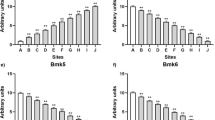Abstract
Multi-biomarker approaches are used to assess ecosystem health and identify impacts of environmental stress on organisms. However, exploration of large datasets by environmental managers represents a major challenge for regulatory application of this tool. Several integrative tools were developed to summarize biomarker responses. The aim of the present paper is to update calculation of the “Integrated Biological Response” (IBR) described by Beliaeff and Burgeot (Environ Toxicol Chem 21:1316–1322, 2002) to avoid weaknesses of this integrative tool. In the present paper, a novel index named “Integrated Biological Responses version 2” based on the reference deviation concept is presented. It allows a clear discrimination of sampling sites as for the IBR, but several differences are observed for contaminated sites according to up- and downregulation of biomarker responses. This novel tool could be used to integrate multi-biomarker responses not only in large-scale monitoring but also in upstream/downstream investigations.


Similar content being viewed by others
References
Arzate-Cardenas MA, Martinez-Jeronimo F (2011) Age-altered susceptibility in hexavalent chromium-exposed Daphnia schodleri (Anomopoda: Daphniidae): integrated biomarker response implementation. Aquat Toxicol 105:528–534
Barillet S, Adam C, Palluel O, Devaux A (2007) Bioaccumulation, oxidative stress, and neurotoxicity in Danio rerio exposed to different isotopic compositions of uranium. Environ Toxicol Chem 26:497–505
Beliaeff B, Burgeot T (2002) Integrated biomarker response: a useful tool for ecological risk assessment. Environ Toxicol Chem 21:1316–1322
Broeg K, Westernhagen HV, Zander S, Korting W, Koehler A (2005) The “bioeffect assessment index” (BAI): a concept for the quantification of effects of marine pollution by an integrated biomarker approach. Mar Pollut Bull 50:495–503
Chèvre N, Gagné F, Blaise C (2003) Development of a biomarker-based index for assessing the ecotoxic potential of aquatic sites. Biomarkers 8:287–298
Damiens G, Gnassia-Barelli M, Loques F, Romeo M, Salbert V (2007) Integrated biomarker response index as a useful tool for environmental assessment evaluated using transplanted mussels. Chemosphere 66:574–583
Hagger JA, Jones MB, Lowe D, Leonard DRP, Owen R, Galloway TS (2008) Application of biomarkers for improving risk assessments of chemicals under the Water Framework Directive: a case study. Mar Pollut Bull 56:1111–1118
ICES (2011) Report of the Study Group on Integrated Monitoring of Contaminants and Biological Effects (SGIMC), 14–18 March 2011, Copenhagen, Denmark. ICES CM 2011/ACOM:30. 265 pp
Kirby MF, Smith AJ, Rooke J, Neall P, Scott AP, Katsiadaki I (2007) Ethoxyresorufin-O-deethylase (EROD) and vitellogenin (VTG) in flounder (Platichthys flesus): system interaction, crosstalk and implications for monitoring. Aquat Toxicol 81:233–244
Lyons BP, Thain JE, Stentiford GD, Hylland K, Davies IM, Vethaak AD (2010) Using biological effects tools to define good environmental status under the European Union Marine Strategy Framework Directive. Mar Pollut Bull 60:1647–1651
Narbonne JF, Daubèze M, Clérandeau C, Garrigues P (1999) Scale of classification based on biochemical markers in mussels: application to pollution monitoring in European coasts. Biomarkers 4:415–424
Payne JF, Mathieu A, Melvin W, Fancey LL (1996) Acetylcholinesterase, an old biomarker with a new future? Field trials in association with two urban rivers and a paper mill in Newfoundland. Mar Pollut Bull 32:225–231
Sanchez W, Porcher JM (2009) Fish biomarkers for environmental monitoring within the Water Framework Directive. TRAC-Trend Anal Chem 28:150–158
Sanchez W, Katsiadaki I, Piccini B, Ditche JM, Porcher JM (2008a) Biomarker responses in wild three-spined stickleback (Gasterosteus aculeatus L.) as a useful tool for freshwater biomonitoring: a multiparametric approach. Environ Int 34:490–498
Sanchez W, Piccini B, Ditche JM, Porcher JM (2008b) Assessment of seasonal variability of biomarkers in three-spined stickleback (Gasterosteus aculeatus L.) from a low contaminated stream: implication for environmental biomonitoring. Environ Int 34:791–798
Sanchez W, Piccini B, Maillot-Maréchal E, Porcher JM (2010) Comparison of two reference systems for biomarker data analysis in a freshwater biomonitoring context. Environ Int 36:377–382
Sanchez W, Burgeot T, Perceval O (2011) Perspectives from the French workshop on the development and validation of biomarkers and bioassays for the monitoring of aquatic environments. Environ Sci Pollut Res 19:1345–1347
Serafim A, Company R, Lopes B, Fonseca VF, França S, Vasconcelos RP, Bebianno MJ, Cabral HN (2011) Application of an integrated biomarker response index (IBR) to assess temporal variation of environmental quality in two Portuguese aquatic systems. Ecol Indic. doi:10.1016/j.ecolind.2011.08.009
Viarengo A, Lowe D, Bolognesi C, Fabbri E, Koehler A (2007) The use of biomarkers in biomonitoring: a 2-tier approach assessing the level of pollutant-induced stress syndrome in sentinel organisms. Comp Biochem Physiol C 146:281–300
Acknowledgments
This work was supported by the French Ministry of Ecology and Sustainable Development (Programme 181—DRC43 and Programme 190 post-grenelle), the European Regional Development Fund in the framework of the INTERREG IV A France (Channel)–England program (DIESE project), and the French Office for Water and Aquatic Environment (ONEMA).
Author information
Authors and Affiliations
Corresponding author
Additional information
Responsible editor: Philippe Garrigues
Rights and permissions
About this article
Cite this article
Sanchez, W., Burgeot, T. & Porcher, JM. A novel “Integrated Biomarker Response” calculation based on reference deviation concept. Environ Sci Pollut Res 20, 2721–2725 (2013). https://doi.org/10.1007/s11356-012-1359-1
Received:
Accepted:
Published:
Issue Date:
DOI: https://doi.org/10.1007/s11356-012-1359-1




